New Perspectives: The Museum of Art at60
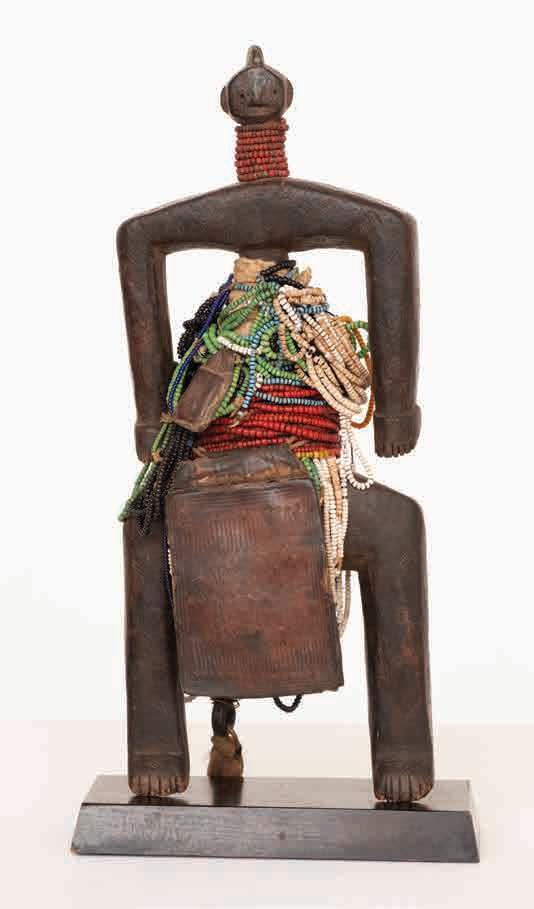


HOFSTRA UNIVERSITY MUSEUM OF ART
Cover images (clockwise, from top left):
African, Cameroon, Dowayo peoples, Namji Fertility Doll, early 20th century, wood with patina, beads, leather, and metal, 11.5 x 4.25 x 2 in., Hofstra University Museum of Art, gift of Dr. and Mrs. Pascal James Imperato, HU2021.5
Conrad Felixmüller (German, 1897-1977), The Happy Marriage/The Married Couple in Winter (Gluchkliche Ehe Iv/Ehepaar Im Winter), 1919, oil on canvas, 26 x 22.25 in., Hofstra University Museum of Art, gift of Mr. and Mrs. Alexander Rittmaster, HU78.28
Gordon Parks (American, 1912-2006), Labyrinth, 1981, dye transfer print, 20 x 29.5 in., Hofstra University Museum of Art, gift of Carole and Alex Rosenberg, HU88.84
HOFSTR A UNIVERSIT Y MUSEUM OF ART
New Perspectives: The Museum of Art at60
September 5-December 15, 2023
Emily Lowe Gallery
The Hofstra University Museum of Art’s programs are made possible by the New York State Council on the Arts with the support of the Office of the Governor and the New York State Legislature.
© 2023 Hofstra University Museum of Art All rights reserved. No part of this publication may be reproduced, stored in a retrieval system, or transmitted, in any form or by any means, electronic, mechanical, photocopying, recording, or otherwise, without prior permission of the Hofstra University Museum of Art.
Director’s Perspective: The Museum of Art at 60
The Hofstra University Museum of Art (HUMA) proudly celebrates 60 years of growth and service to the Hofstra University community and the residents of the New York metropolitan region. The past 60 years have seen the transformation of HUMA from a single gallery space constructed in 1963 to an American Alliance of Museums-accredited university fine art museum, serving audiences with high-caliber original exhibitions and educational programming throughout each year. HUMA has been recognized for its efforts by the National Endowment for the Arts and New York State Council on the Arts, as well as by other organizations. University students and faculty utilize the changing exhibitions and extensive permanent collection as catalysts for discussion and as integral components of their pedagogy and educational experiences. Public school children in prekindergarten through 12th grade have meaningful introductions and extended learning experiences with works of art in the HUMA galleries. These experiences connect directly to their classroom curricula and enhance skills that are so vital in our changing and complex world.
This exhibition celebrates the great range and quality of works in the permanent collection of more than 5,200 works of art, dating from 1500 B.C.E. to the 21st century, and demonstrates the Museum’s continued commitment to excellence. The collection includes paintings, prints, drawings, photographs, and sculpture with an emphasis on American and European art. Additional components of the collection include African, Asian, Melanesian, and Central and South American artifacts. We thank those individuals who over the past decades have gifted works of art to the Museum. Their philanthropy and generosity will enhance the cultural and educational life of Hofstra University and the Long Island region for generations to come.
For this exhibition, New Perspectives: The Museum of Art at 60, the Museum asked 10 individuals, from the University and local communities, to curate “mini” exhibitions. The guest curators reviewed the collection database, examined works in collection storage, and created their selections. Their entries express their individual points of view and perspectives. They vary in style and content, depending upon their interests and focus.
While this exhibition features only a small portion of the resources represented in the expansive collection, the depth and breadth of the collection is exemplified by the works that have been selected. We hope the works of art highlighted here will convey a sense of the collection’s importance, particularly for object-based learning with students, faculty, and the public.
As we look to the future, the Museum will continue to initiate and facilitate rich and varied cultural and artistic explorations in an atmosphere that promotes an open exchange of ideas. To help achieve our mission and vision, we are most fortunate to have the support of administrators, alumni, artists, educators, faculty, friends, staff, and students, along with the broader community. We owe our growth and success to their support and numerous contributions
A big thank-you to the guest curators for their creativity and insight:
Hon. Taylor Darling
New York State Assemblywoman, District #18, Nassau County, NY
E. Christa Farmer, PhD
Professor, Department of Geology, Environment, and Sustainability, Hofstra University
Martha Hollander, PhD
Professor, Department of Fine Arts, Design, Art History, Hofstra University
Jonathan Lightfoot, PhD
Director, Center for “Race,” Culture and Social Justice
Professor, Department of Teaching, Learning and Technology, Hofstra University
Veronica A. Lippencott, PhD
Director, Africana Studies Program
Associate Director, Center for “Race,” Culture and Social Justice
Adjunct Associate Professor, Department of Global Studies and Geography, Hofstra University
Margarita Lopez
MA in Creative Arts Therapy Counseling, Hofstra University, Class of 2023
Charles G. Riordan, PhD
Provost and Senior Vice President for Academic Affairs, Hofstra University
Michael Runkel
Director of Grounds and Landscape, Physical Plant Department, Hofstra University
Edward M. Segal, PhD, P.E.
Associate Professor, Department of Engineering, Hofstra University
Erik Jamal Sumner
Art Teacher, Northern Parkway Elementary School, Uniondale, NY
Karen T. Albert Director, Hofstra University Museum of Art
4 5
TAYLOR DARLING Assemblywoman 18 District

Hofstra University’s 60th Museum Anniversary
I chose the following pieces of art for Hofstra University’s 60th Museum Anniversary due to their bold feminine qualities and their ability to captivate and engage the onlooker for further examination. These artworks, each in their unique way, possess a powerful feminine energy that resonates with the theme of the anniversary celebration and contributes to a diverse and thought-provoking exhibition.
The Dowayo peoples’ Namji Fertility Doll is a fascinating representation of feminine power and fertility. Its intricate craftsmanship and vibrant adornments draw the viewer’s attention and invite them to explore the cultural significance of the doll within the Dowayo community. By including this piece, I aimed to showcase the rich heritage and the strong connection to femininity and fertility that the doll embodies.
George Gach’s Maternity, created in 1963, presents a profound portrayal of the bond between a mother and child. The sculpture’s tender and emotional depiction of motherhood resonates with viewers on a deeply personal level. Its bold use of expressive carving captivates the onlooker, evoking a sense of empathy and appreciation for the inherent strength and nurturing qualities associated with motherhood.
Dong Kingman’s Harlem Girl captures the spirit and resilience of an African-American woman in an urban environment. The artwork’s vibrant colors and dynamic composition immediately draw the viewer in, encouraging them to contemplate the experiences, challenges, and triumphs of women within the African-American community. By showcasing this piece, I aimed to celebrate the boldness and vitality of the feminine presence in diverse cultural contexts.
Anton Mauve’s Untitled ceramic tile brings a touch of elegance and refinement to the exhibition. Its delicate craftsmanship and subtle beauty create an atmosphere of contemplation and intrigue. By including this ceramic tile, I sought to highlight the artistic versatility and creativity of women, showcasing the ability to transform functional objects into works of art.
Howardena Pindell’s Untitled #9B (Genesis II) challenges traditional artistic conventions and invites viewers to delve deeper into its intricate layers of mixed media. The artwork’s bold and experimental qualities provoke curiosity and encourage the audience to question and explore the complex intersections of identity and personal narrative. By featuring this piece, I intended to emphasize the importance of diverse perspectives and the power of women artists to push artistic boundaries.
Overall, the chosen pieces for Hofstra University’s 60th Museum Anniversary represent the bold and captivating feminine qualities that engage viewers and invite them to delve further into the multifaceted aspects of femininity, cultural heritage, and personal narratives. These artworks contribute to a diverse and compelling exhibition that celebrates the artistic achievements and the significant role of women in shaping our understanding of the world through art.
All My Best, Member of Assembly District 18

George Gach
(American, born Hungary, 1909-1996) Maternity, 1963 Wood

51.875 x 25.25 x 9 in.
Hofstra University Museum of Art, gift of Dr. and Mrs. Daniel Mason HU86.80
6 7 ALBANY OFFICE: Room 323, Legislative Office Building, Albany, New York 12248 518-455-5861, FAX: 518-455-4329 DISTRICT OFFICE: 33 Front Street, Suite 303 Hempstead, New York 11550 | 516-489-6610, FAX: 516-538-3155 EMAIL: darlingt@nyassembly.gov
COMMITTEES Children and Families Economic Development, Job Creation, Commerce and Industry Local Governments Small Business Transportation
THE ASSEMBLY STATE OF NEW YORK ALBANY
Dong Kingman (American, 1911-2000)
Harlem Girl, undated Oil and collage on Masonite

31.25 x 24 in.
Hofstra University Museum of Art, gift of Dr. Alfred Brotman HU74.09
Howardena Pindell (American, born 1943)
Untitled #9B (Genesis II), 2007
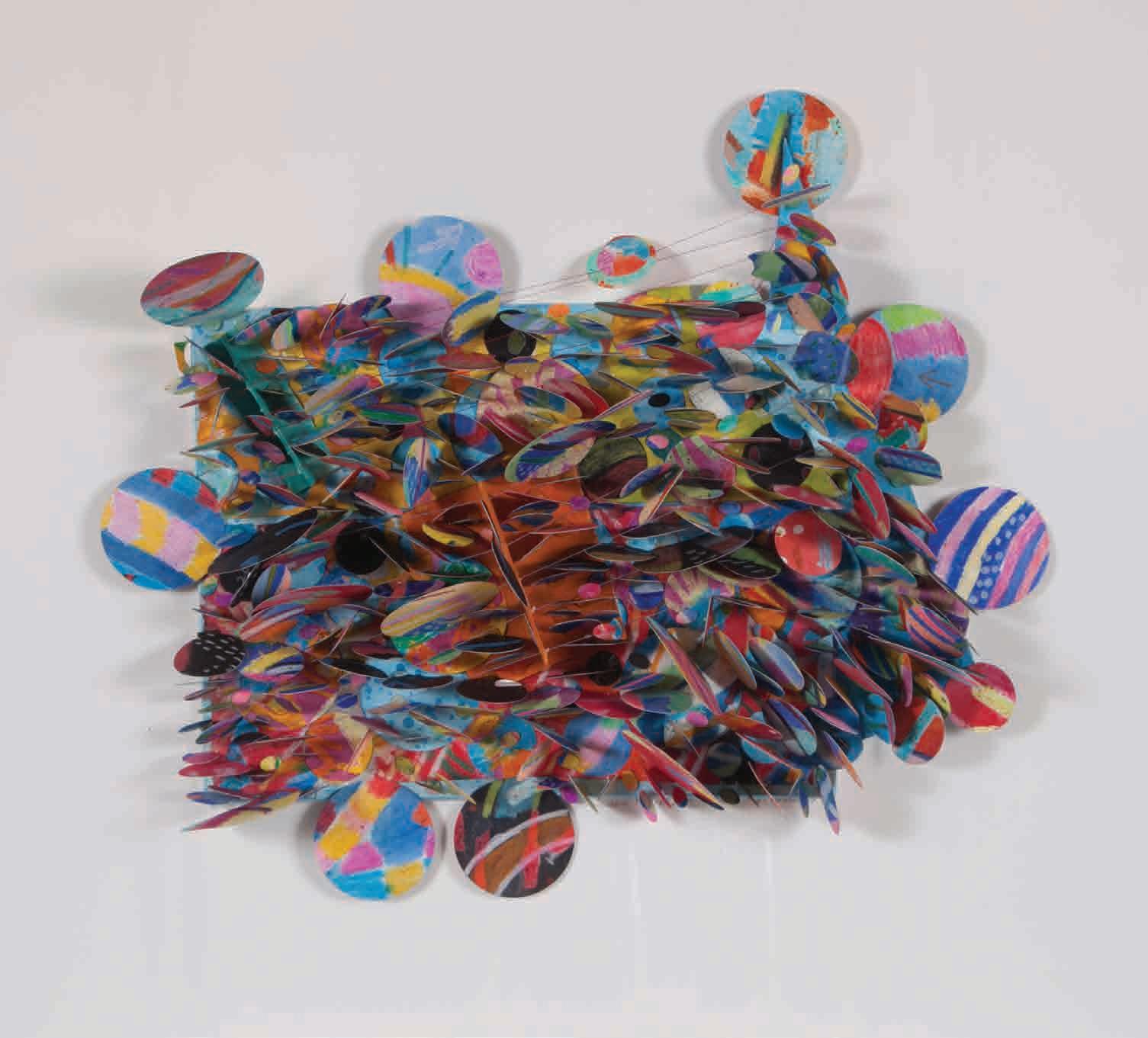
Watercolor, acrylic, thread, ink, oil stick, color pencil, and museum board
13 x 10.75 x 3 in.
Hofstra University Museum of Art, gift of the artist HU2012.51
8 9
Our Planet, Ourselves
I had so much fun looking through the Hofstra University Museum of Art collection to select these works of art for this exhibition commemorating 60 years of the Museum. I love photography, and I teach earth science, so I was drawn to several beautiful images of our planet. The grand sweep of Kazhitna Glacier, Denali, Alaska, 1990 by Marilyn Bridges symbolizes for me not only the majesty of the Earth’s climate system, but also its power to raise sea levels and affect us – even here on Long Island, so far away from the glaciers. And of course, I had to choose another Bridges’ image, Crater, Andagua, Peru, for its contrasting landforms of the sinuous eroded hills behind the nearly conical volcanic crater.
In the very small scale, the regular polygons of Brett Weston’s Mud Cracks intrigue me, as I teach sedimentation. Another image of Weston’s, Lava and Plant, Hawaii, represents to me the tight symbiotic relationship between the Earth and the living organisms that can be found everywhere we have looked.
A pair of lithographs by Louis Lozowick, Into the Canyon and Open Mine (Crushed Rock), tell me many stories of the Earth and our relationship to it. What do they say to you?
I chose the last two photographs because of their localities near Hofstra. Tom Baril’s lovely image of Taughannock Falls #2 reminds me of several places I have been in New York state on field trips with students and other professors in the Geology, Environment, and Sustainability Department, particularly Kaaterskill Falls in the Catskills and Awosting Falls in the Shawangunks. Finally, I love the dynamic sky in Barbara Roux’s Storm Approaching From the Sound and its lovely portrayal of Long Island’s important marshes.
Happy Birthday, HUMA! Here’s to many more.
E. Christa Farmer, PhD Professor, Department of Geology, Environment,
and Sustainability, Hofstra University
Marilyn Bridges (American, born 1948)
Kazhitna Glacier, Denali, Alaska, 1990, from the portfolio Heightened Perspectives, 1990 Gelatin silver print

14.75 x 18.75 in.
Hofstra University Museum of Art, gift of Susan and Steven Ball HU95.14.9
10 11
Barbara Roux (American, born 1945)
Storm Approaching From the Sound, 2010
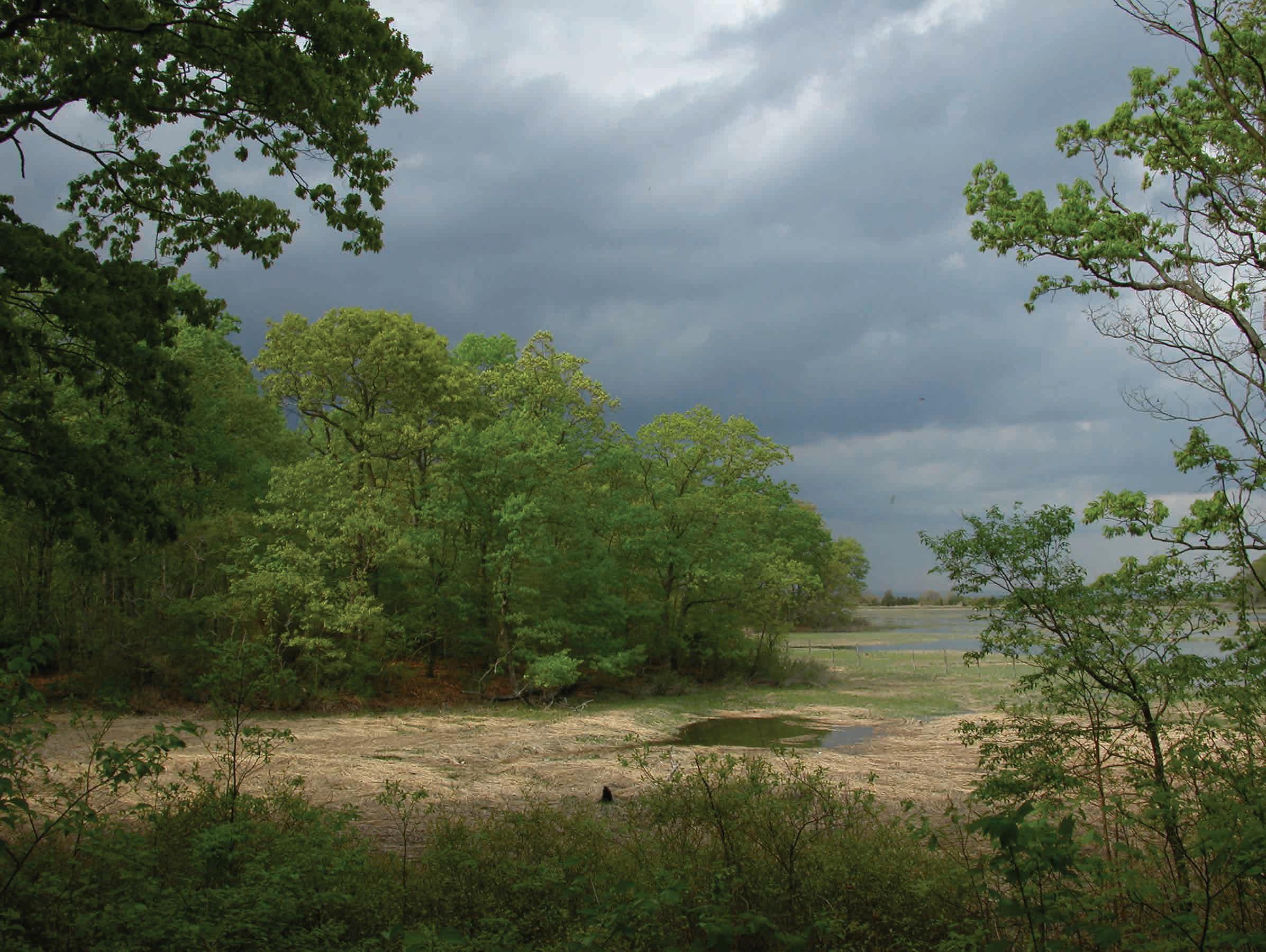
Digital print
12 x 18 in.
Brett Weston (American, 1911-1993)
Mud Cracks, 1977
Gelatin silver print
10.5625 x 13.6875 in.
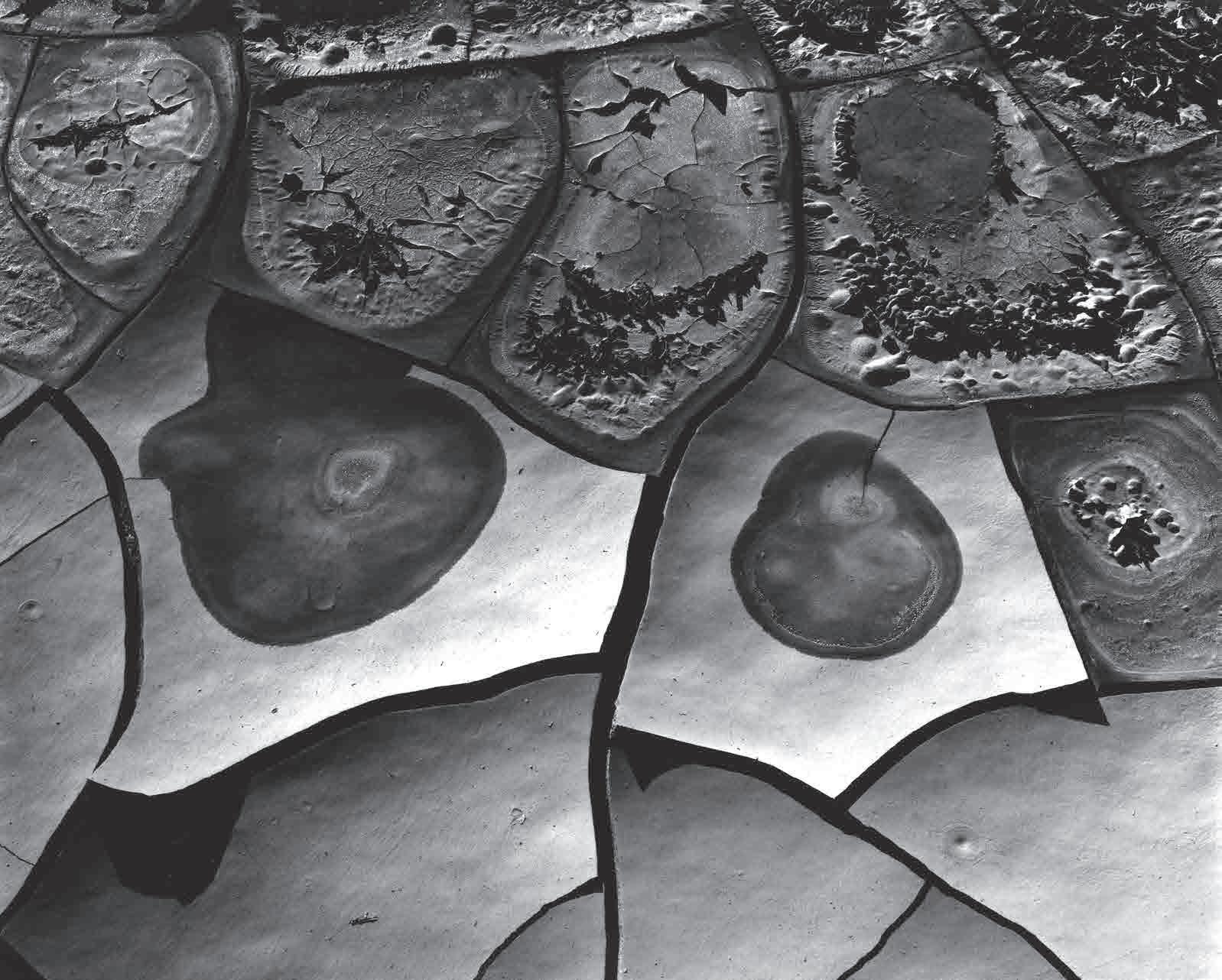 Hofstra University Museum of Art, gift of the artist HU2012.3
Hofstra University Museum of Art, gift of the artist HU2012.3
12 13
Hofstra University Museum of Art, gift of the Christian Keesee Collection HU2021.24
The Museum and its Atmosphere: Art 1960-65
What was happening in the world of early 1960s art when the Hofstra University Museum of Art was founded? What were visual artists exploring? What were their priorities? How did they respond to the world around them? How did this sensibility shape Hofstra’s collectors?
By 1960, following a seismic cultural shift, the capital of contemporary Western art was no longer Paris, but New York. The diversity of the art world was stunning. (In fact, the term “artworld” was introduced in 1964 by critic Arthur Danto.) Some artists pursued already established modern ideas like abstraction and cubism; others explored new styles, subjects, and materials. Abstract expressionism, America’s first internationally recognized art movement, was barely 15 years old. Photography was being driven beyond documentation into aesthetic and conceptual realms. New forms of printmaking were evolving. Other artists reinvigorated conventional media and styles with new subjects.
Ironically, despite this exciting creative innovation, a great many artistic institutions (art schools, museums, and galleries) still functioned as gatekeepers of tradition, often unconsciously discriminating against women and people of color. It was only later in the decade, continuing into the 1970s and beyond, that these norms began to be substantially challenged.
My micro-exhibit brings together eight works, each by a different artist, created between 1960 and 1965. They represent a wide range of styles, subjects, media, and approaches. We find examples of traditional media, like oil painting, charcoal drawing, and bronze sculpture; more modern techniques, like photography and lithography; and the newly used screenprinting technique. We find representation of human and animal life, pure abstraction, and work that negotiates between them. The eight artists represented here experienced various levels of professional training, success, and renown.
As a group, these works reveal the artistic plurality of the early ’60s. At the same time, they invite us to see their underlying connections, often in conversation with one another. How do these different artists approach the same materials? Beyond common media and techniques, how do they approach similar subjects and forms? How do they use color, or its absence? How do they evoke intense feeling, or moments of everyday life?
Martha Hollander, PhD Professor, Department of Fine Arts, Design, Art History, Hofstra University
Joan Mitchell (American, 1925-1992)

Metro, c. 1965
Oil on canvas
20 x 17 in.
Hofstra University Museum of Art, gift of Dr. and Mrs. Milton Gardner HU80.15
14 15
Danny
Cal, Springfield, Illinois, 1965
Gelatin silver print
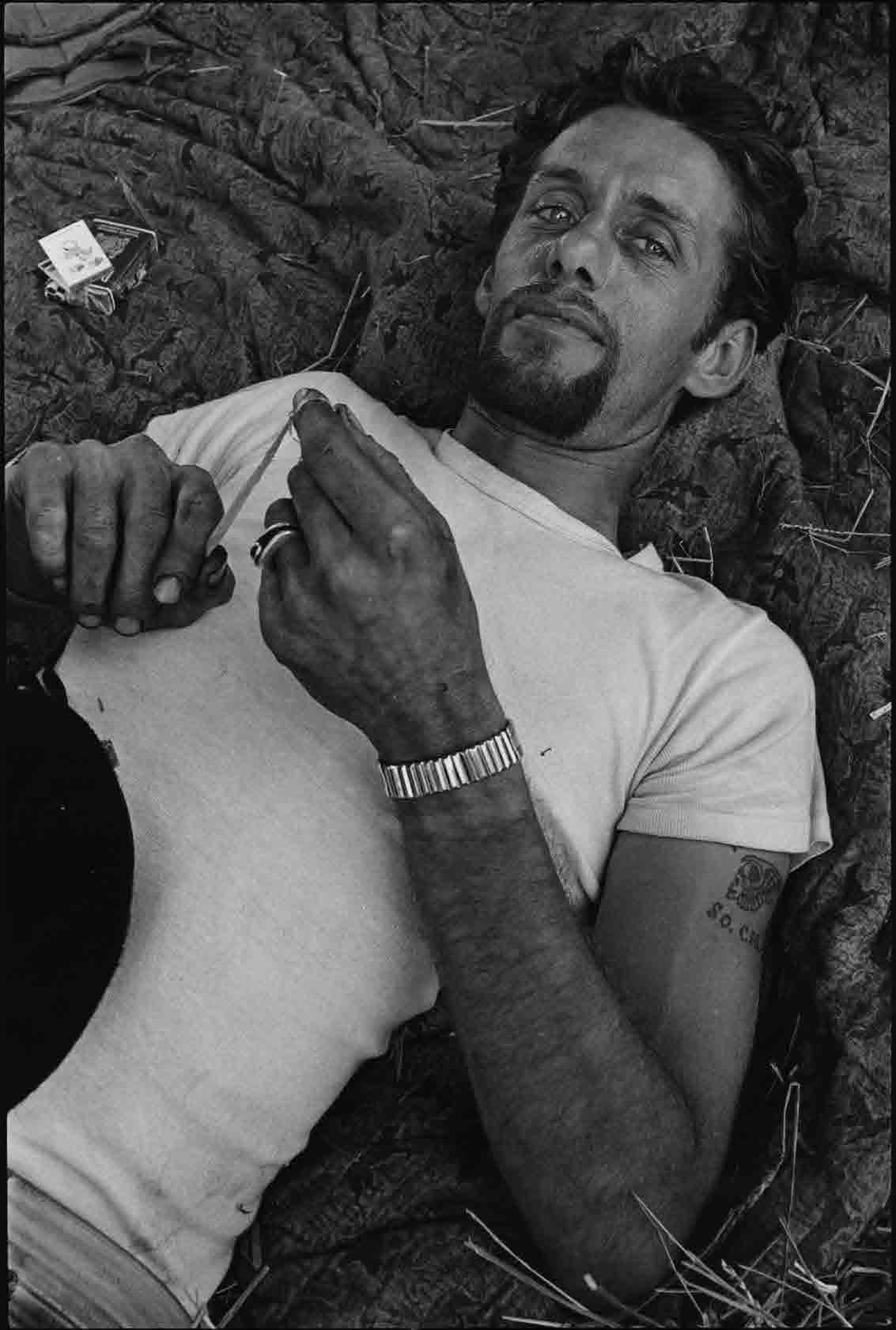
13.25 x 9 in.
Stunt Man #1, 1962
Lithograph
17 x 13 in.
 Lyon (American, born 1942)
Hofstra University Museum of Art, gift of George Stephanopoulos HU2009.7.19
Robert Rauschenberg (American, 1925-2008)
Lyon (American, born 1942)
Hofstra University Museum of Art, gift of George Stephanopoulos HU2009.7.19
Robert Rauschenberg (American, 1925-2008)
16 17
Hofstra University Museum of Art, gift of Dr. Milton M. Gardner HU70.101
Reflections on African Ar t
There are growing debates about the restitution and repatriation of sub-Saharan African art and cultural heritage in museums and private collections around the world. More than 90% of all cultural artifacts known to originate in Africa are displayed in Europe. This startling fact is part of the long, brutal legacy of European colonialism.
Nigeria has spent years trying to recover its Benin Bronzes, a collection of several thousand sculptures that were stolen by the British in the late 19th century. There have been waves of returns, prompted by social movements such as Black Lives Matter and Rhodes Must Fall. However, repatriation is far from complete, as institutions like the British Museum have remained silent despite housing the largest permanent collection of African arts and culture in the world.
In striking contrast, Hofstra University Museum of Art has a wonderful collection of African art, which does not share the brutal history of conquest and theft. The Museum collection contains 300 works of traditional African art representing 80 different cultures, mainly from west and central Africa. African artifacts have been donated since the 1960s and most were created in the late 19th and early 20th centuries. These works are integral to education programs across campus and the wider community.
From a geographic perspective, Hofstra’s collection of African artifacts offers opportunities to discover the rich historical, cultural, and environmental diversity of sub-Saharan Africa. The collection even includes a fake Benin bronze (HU66.3) that was added to the collection in 1966. The intricate bronze art of Benin illustrates the vitality of these precolonial Africana metalworking industries.
The African collection also includes female face masks of the Dan peoples of Côte d’Ivoire, which express feminine beauty (HU85.58, HU2016.1). These masks were used in masquerade performances and are made of wood with pigment and patina. What is noteworthy about these masks is that one is bare and void of its original attachments, usually done to attract Western consumers. The other mask is in its original form, which includes the adornments of metal, hair, animal teeth, and yarn.
Much of the African art in the collection is utilitarian, reflecting the skills and resources of communities that are specific in time and place. The art of the Dogon people of present-day Mali and Burkina Faso includes masks, jewelry, and other objects (HU2005.3.16, HU2005.3.2, HU2005.3.42). The Dogon are an agrarian society who cultivate crops such as sorghum, millet, and rice. These crops were first domesticated in sub-Saharan Africa. They harvested the grain and stored them in granaries with wooden doors and locks that are intricately carved with images (HU2005.3.30).
The Dogon region of Mali has a thriving tourism industry. Utilitarian objects and ceremonies take center stage as visitors come from around the world. Western consumption of African art and customs dates back well over a century. As we appreciate these African works of art, please be mindful of their important significance to African peoples, their artistic traditions, and rich cultures, all of which deserve our respect and dignity.
Jonathan Lightfoot, PhD
Director, Center for “Race,” Culture and Social Justice Professor, Department of Teaching, Learning and Technology, Hofstra University
Veronica A. Lippencott, PhD Director, Africana Studies Program Associate Director, Center for “Race,” Culture and Social Justice Adjunct Associate Professor, Department of Global Studies and Geography, Hofstra University
African, Côte d’Ivoire, Dan peoples Female Face Mask (Deangle or Tankagle), 19th-mid 20th century Wood with pigment and patina

9.5 x 6 x 4 in.
Hofstra University Museum of Art, gift of Josephine and Sol Levitt HU85.58
18 19
African, Côte d’Ivoire, Dan peoples Mask with Full Coiffure and Brass Bells, late 19th-early 20th century Wood with cloth, raffia, reeds, brass, iron, and patina
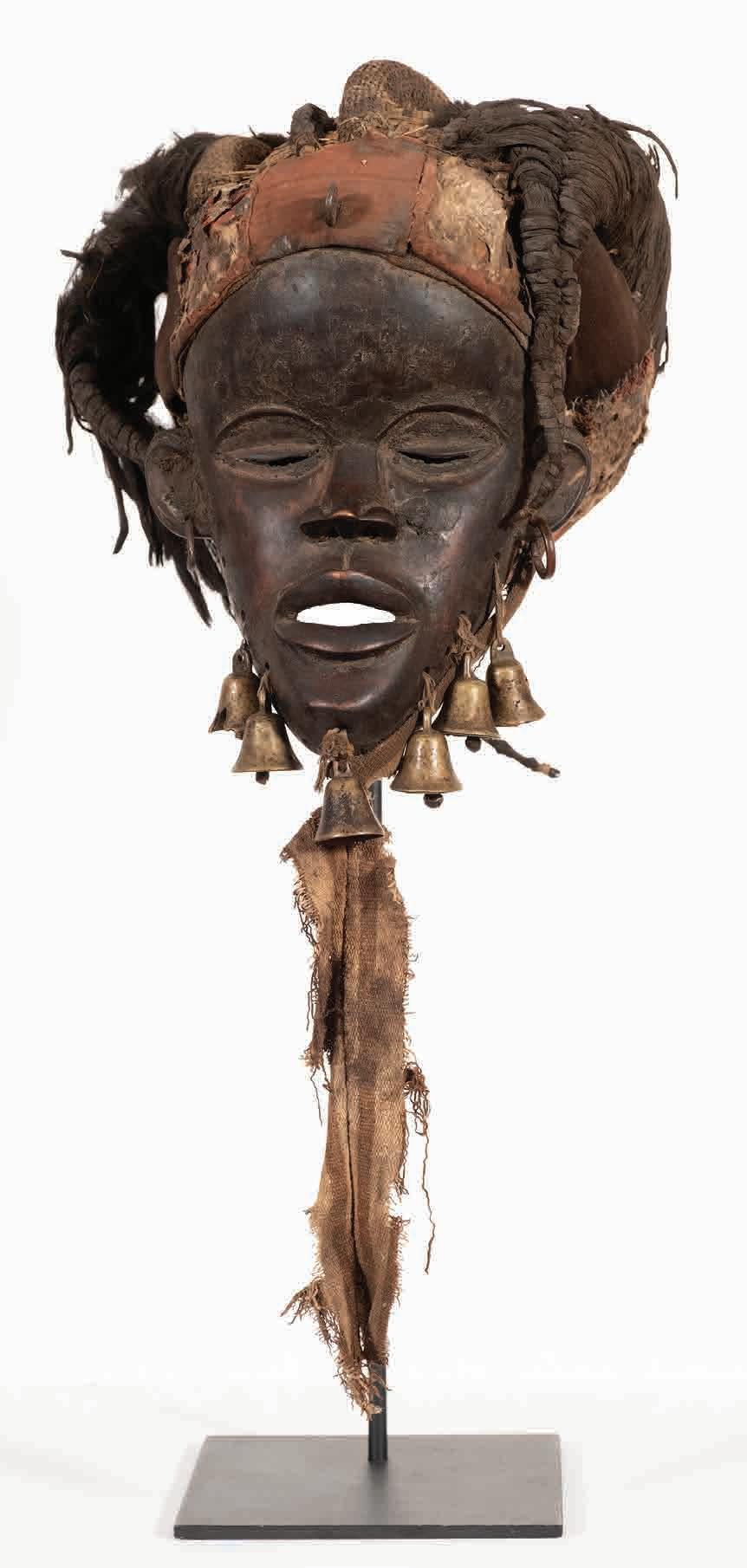
26.5 x 12.5 x 13 in.
Hofstra University Museum of Art, gift of Dr. and Mrs. Pascal James and Eleanor Imperato HU2016.1
African, Mali, Dogon peoples Monkey Mask, early-mid 20th century Wood with pigment and patina

11.5 x 5.75 x 4.5 in.
Hofstra University Museum of Art, gift of Roda Graham HU2005.3.16
20 21
Embracing Collage
In art therapy, collage acts as a nonthreatening material for those who may be weary of the artmaking process. It invites creative expression and communication through the exploration of nontraditional media and techniques. What I enjoy most about collage-making is the freedom that comes with how one defines a “collage”; there are no rules. The lack of pressure allows you to be present and enjoy the physicality of the media, such as ripping paper or layering different textures. It becomes a full body experience. Collage encourages free association and individuality by taking materials and challenging their traditional meaning and purpose. The Museum works chosen display the versatility, engagement, and playful style that collage can offer its viewers and partakers
Benny Andrews (American, 1930-2006)
Chasty, 1961
Mixed media, oil and collage on canvas

18.25 x 24 in.
Hofstra University Museum of Art, gift of Dr. and Mrs. Joseph Tucker HU85.2
22 23
Margarita Lopez
MA in Creative Arts Therapy Counseling, Hofstra University, Class of 2023
Lee Krasner (American, 1908-1984)

Free Space (Yellow), 1975
Screenprint and collage on Arches paper, deluxe edition
19.5 x 26 in.
Hofstra University Museum of Art, gift of Carole and Alex Rosenberg HU88.13
Max Papart (French, 1911-1994)
Untitled, 1975
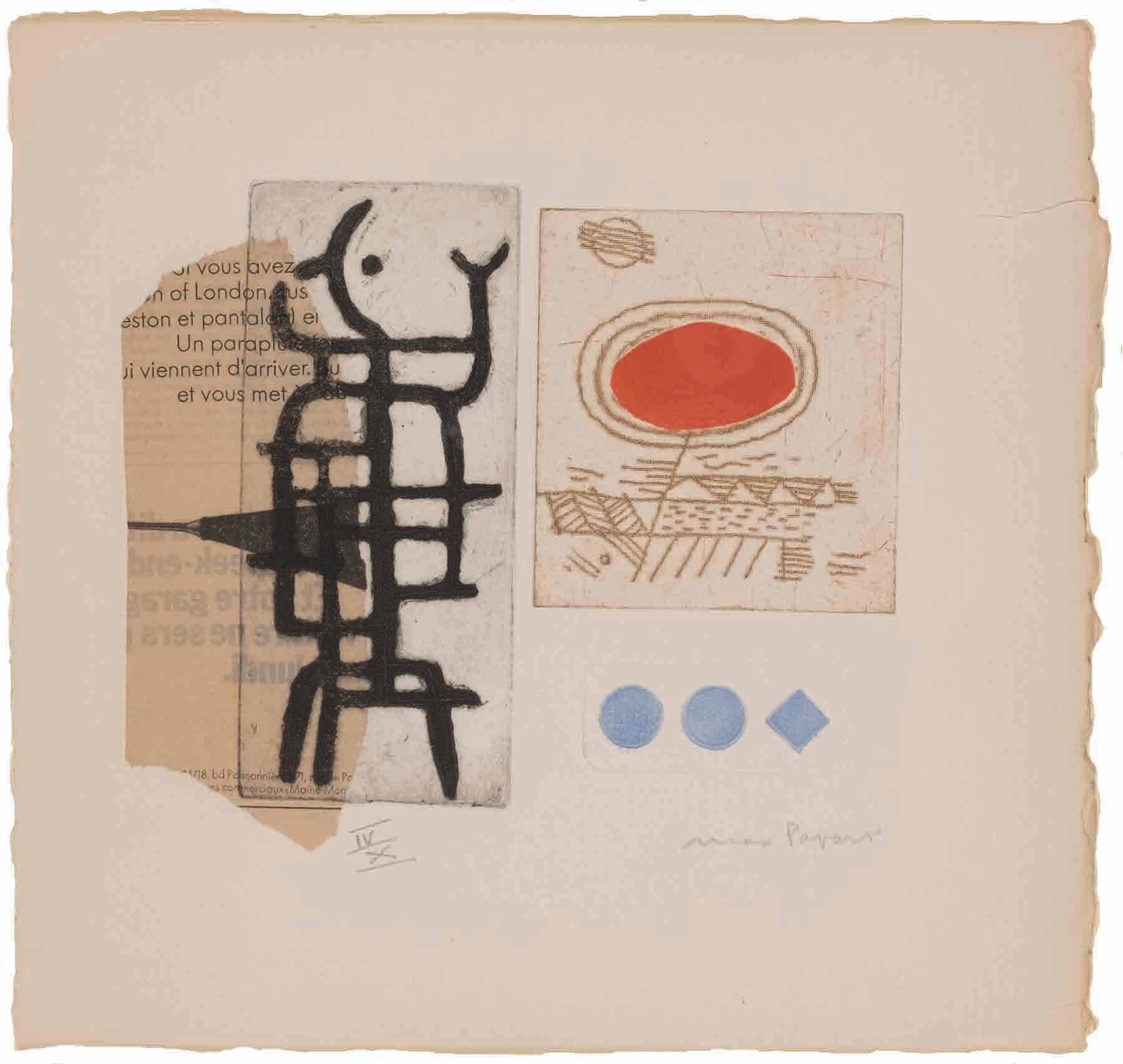
Etching and collage
6.5 x 7 in.
Hofstra University Museum of Art, gift of Carole and Alex Rosenberg HU86.198
24 25
Provost’s Selection
Charles G. Riordan, Hofstra’s provost and senior vice president for academic affairs, selected four diverse works of art of different media from the collection: two paintings, a photograph, and a screenprint. Conrad Felixmüller’s The Happy Marriage/The Married Couple in Winter (Gluchkliche Ehe Iv/Ehepaar Im Winter), with its distorted angles and fragmented images, is an excellent example of the German expressionist style. In contrast, American impressionist Jane Peterson’s The Lagoon, Venice captures the light reflecting off the water using broad brush strokes and vibrant colors. Photographer Berenice Abbott created images depicting principles of physical science, as shown in Falling Balls of Unequal Mass. To achieve her desired results, she developed new techniques and holds a number of patents for equipment she created. Ben Shahn, whose work often addresses social or political causes, illustrates Scientist with a combination of abstract and realistic elements.
Berenice Abbott (American, 1898-1991)
Falling Balls of Unequal Mass, 1958, from the portfolio Retrospective, 1982

Gelatin silver print
23 x 9 in.
Hofstra University Museum of Art, gift of Lazarus Weiner HU83.28
26 27
Jane Peterson
(American, 1876-1965)
The Lagoon, Venice, 1920

Oil on canvas 32 x 32 in.
Ben Shahn
(American, born Lithuania, 1898-1969)
Scientist, 1957
Screenprint with hand-coloring 12 x 10 in.
 Hofstra University Museum of Art, gift of Martin Horwitz HU72.1
Hofstra University Museum of Art, gift of Martin Horwitz HU72.1
28 29
Hofstra University Museum of Art, gift of Ralph Barrocas HU2009.2.3
Nature: Beauty, Power, and Appreciation
We live in the age of technology and we often take for granted all that nature offers. When you look collectively at all five works, there is a story told about the beauty of nature, the power of nature, our deviation from nature, and how we must foster an appreciation of nature. Atchafalya and Tanah Lot, both by Sally Gall, illustrate the beauty of our natural landscapes in the form of a bald cypress grove and a breaking ocean wave. The latter demonstrates how powerful nature can be. The movement and abrasion of the ocean can lead even the mightiest of trees to be left as driftwood, like the sculpted tree pictured in Brett Weston’s Driftwood.
To New York (Approaching New York) by Victoria Hutson Huntley depicts our deviation from nature, as the lithograph shows New York City surrounded by grassy plains. We know all too well that development and urbanization have altered this pastoral landscape, leaving only remnants of the plains of Long Island. As a result, we must cultivate a new appreciation for nature and all it offers – an appreciation that is personified by J. Seward Johnson Jr.’s Creating. The bronze sculpture depicts a man sitting at the base of tree, enjoying the landscape around him and documenting the experience by sketching the tree before him.
Michael Runkel Director of Grounds and Landscape, Physical Plant Department, Hofstra University
Sally Gall (American, born 1955)
Tanah Lot, from the portfolio Selected Landscapes, 1992 Gelatin silver print

15 x 15.125 in.
Hofstra University Museum of Art, gift of Susan and Steven Ball HU99.14.8
30 31
Victoria Hutson Huntley (American, 1900-1971)
To New York (Approaching New York), 1933
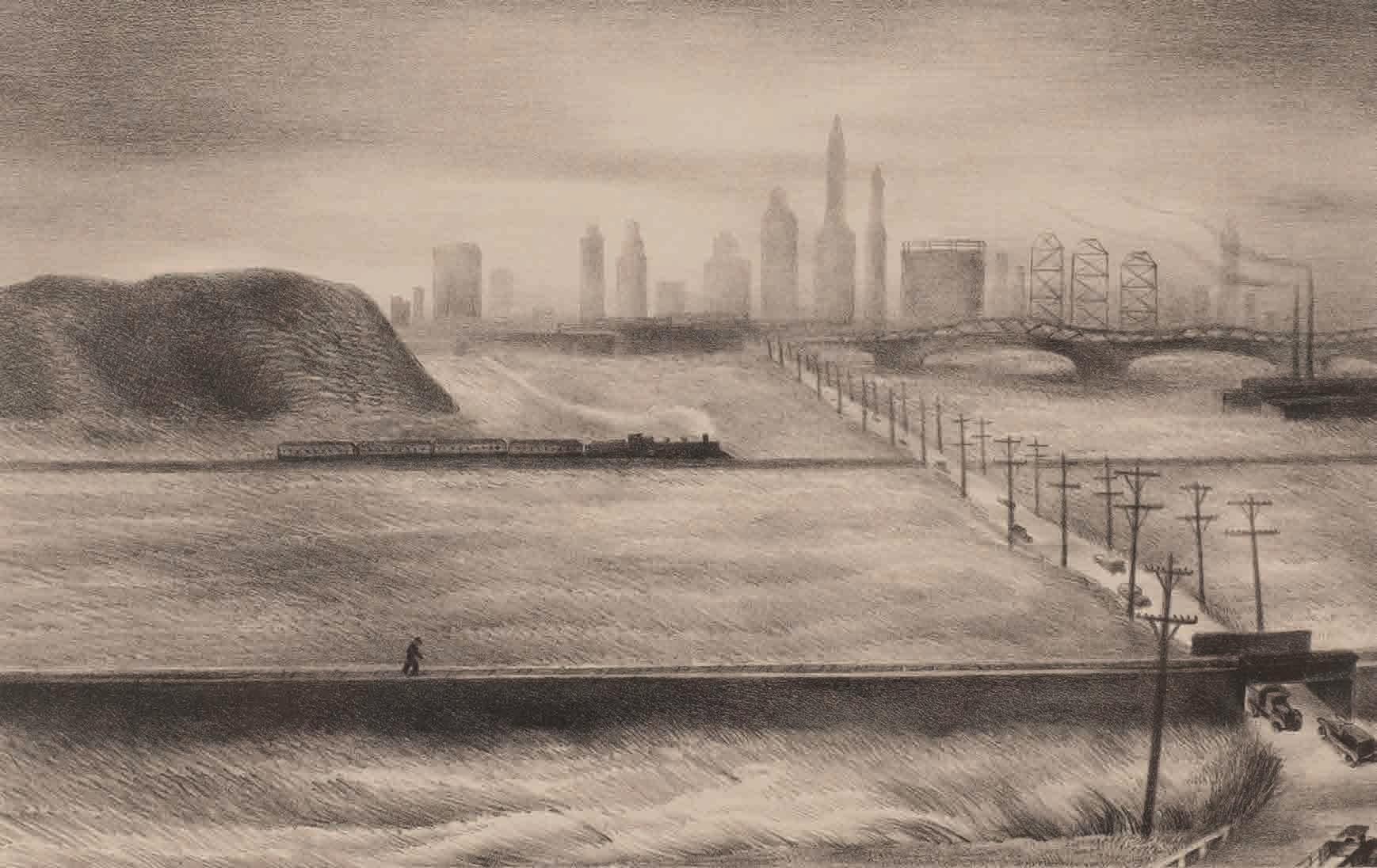
Lithograph
7.875 x 12.375 in.
Brett Weston (American, 1911-1993)
Driftwood, 1958
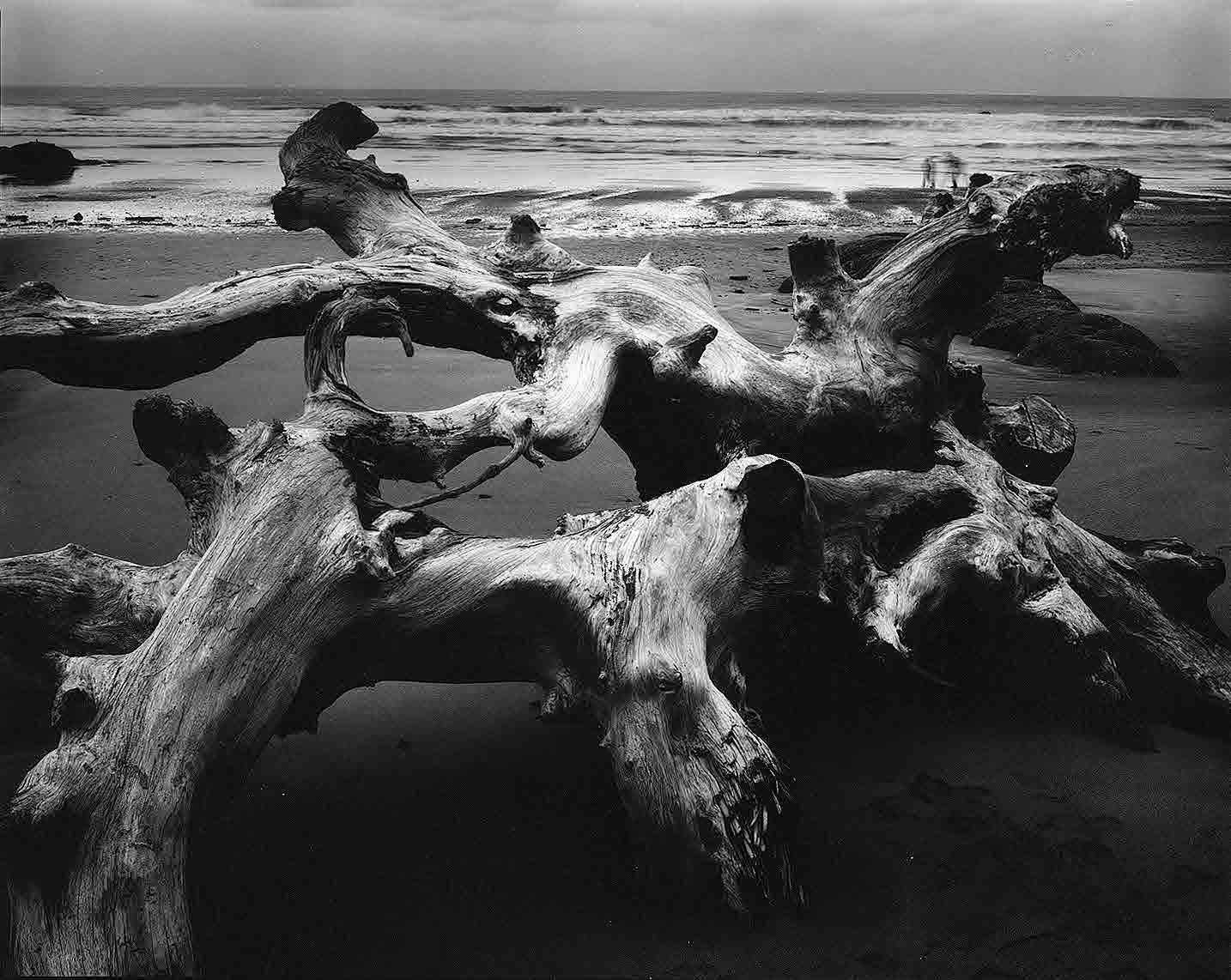
Gelatin silver print
7.75 x 9.6875 in.
Hofstra University Museum of Art, gift of Daniel Mason HU77.98
32 33
Hofstra University Museum of Art, gift of the Christian Keesee Collection HU2021.9
Wood as Subject, Tool, and Medium
As a structural engineer who teaches students and designs new structures, I am well acquainted with wood as a building material. While designers frequently use wood in construction, wood has recently been used for new applications, as it is often regarded as a sustainable alternative to other major construction materials like concrete and steel. Perhaps more than any other material, wood links the natural environment to the built environment. On a daily basis, we interact with wood in nature and in our buildings (both the buildings themselves and the objects in the buildings). It is no surprise then that wood is also a material that artists both feature in and use to create their works. This “mini” exhibition focuses on the versatility of wood by showing it as the subject in photographs, the tool used to create prints, and the medium of artifacts and sculptures.
Lucien Clergue’s Sicilian Botanic Garden I and Brett Weston’s Wood photographs both treat wood as the subject. Sicilian Botanic Garden I shows the lower few feet of a series of tree trunks while Wood is a close-up of wood panels. The former is of wood in its natural state, while the latter shows wood after processing. Both images are immediately recognizable as wood, but the juxtaposition reminds us of the transformation that wood often undergoes on its way from the natural to the built environment.
Louis Schanker’s Polo and Katsuhika Hokusai’s Mishima Pass in Kai Province were both created through relief printing using wood as a tool. Polo is a woodcut print of a black and white abstract image of a figure and a horse. In contrast, Mishima Pass in Kai Province is a woodblock print of a color landscape with fine features. With this work, there is no trace that wood was the tool used to generate the print. Wood can be just an anonymous tool.
The ceremonial War Club created by Massim peoples and Standing Male Figure, a work by Dogon peoples, are two sculptures each constructed from a single piece of wood. The War Club is straight, smooth, and covered in precise carvings. The Standing Male Figure is rougher than the War Club, but its most prominent feature is the figure’s bent posture, which was realized by carving a curved piece of wood. The form is matched to the available material, or perhaps a material was finally found to create the desired form.
The six works on display show how these artists have focused on and/or used wood in a range of ways. Once outside the exhibition, it won’t take you long to encounter wood again. A reminder that this humble material that occasionally transcends usefulness – and becomes a piece of art – is ever-present as we pass back and forth between the natural and built environments.
Edward M. Segal, PhD, P.E. Associate Professor, Department of Engineering, Hofstra University
Katsushika Hokusai (Japanese, 1760-1849)

Mishima Pass in Kai Province (Koshu mishima-goe), from the series Thirty-Six Views of Mt. Fuji, 1830-1831 Color woodblock print, ink and color on paper 10 x 14.875 in.
Hofstra University Museum of Art, gift of Helen Goldberg HU2003.8.3
34 35
Melanesia, Kiriwina Islands, Papua New Guinea, Massim peoples War Club, early-mid 20th century

Wood with pigment
34.25 x 5.25 x 0.75 in.
HU73.92
Brett Weston (American, 1911-1993) Wood, 1975
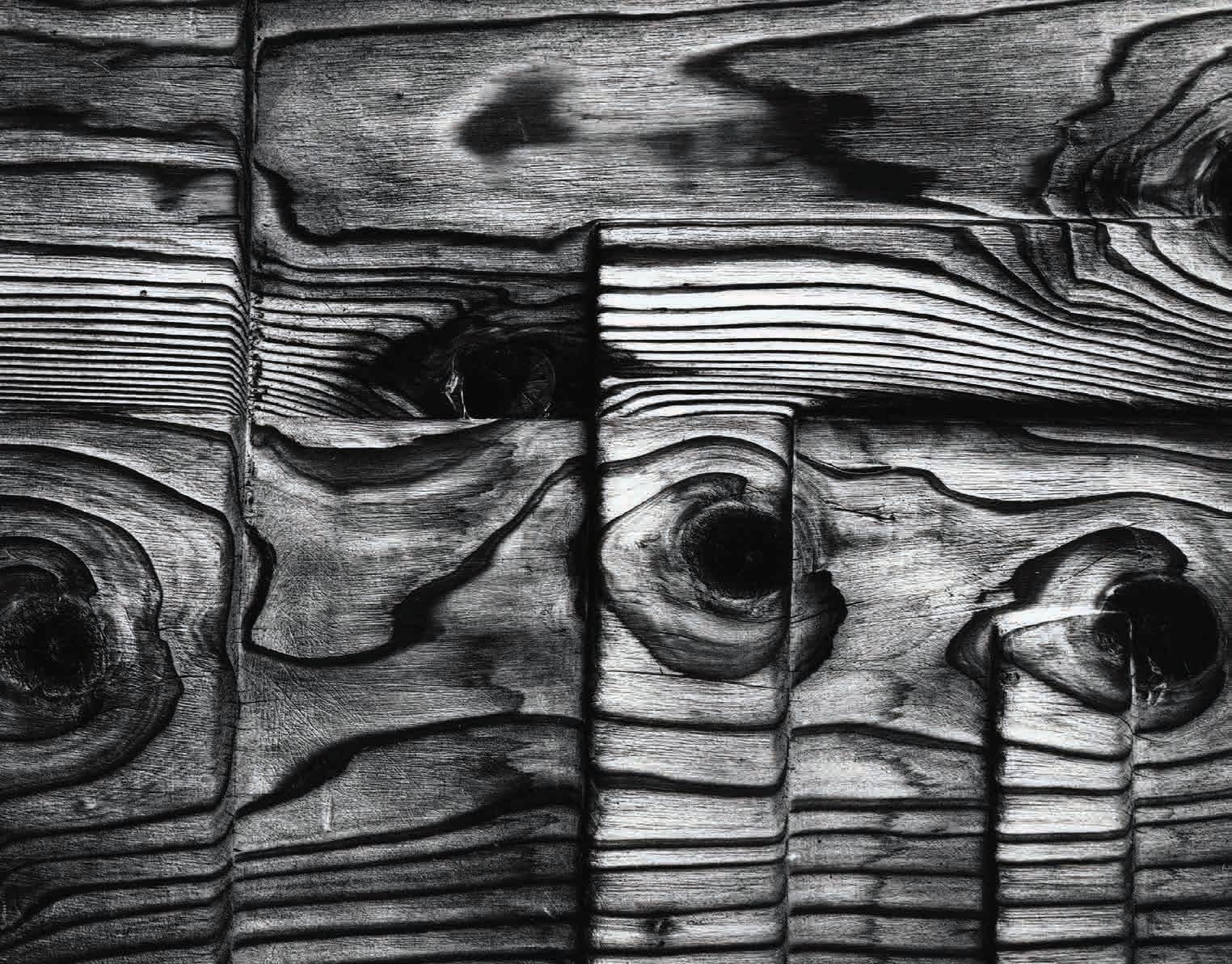
Gelatin silver print
10.6875 x 13.625 in.
HU2021.30
Hofstra University Museum of Art, gift of Cedric H. Marks
36 37
Hofstra University Museum of Art, gift of the Christian Keesee Collection
Gordon Parks’ Instinctive Travels and His Paths of Rhythm: The Lost Mixtape
Yo, yo, yo! I go by the name of Erik Jamal Sumner, and as curator of this mini exhibition, I present to you THE worldrenowned iconoclastic photographer, Gordon Parks! Walk with me as I masterfully blend unfamiliar, “lost” works of Parks into a set that pairs his experimental pulchritudinous photos with classic hip-hop. So come alive y’all, and let me proceed to give you what you need in 2023, Gordon Parks’ Instinctive Travels and His Paths of Rhythm: The Lost Mixtape.
Track 1
From the day he was born, Gordon Parks encapsulated Public Enemy’s song title Black Steel in the Hour of Chaos. Pairing this title with Vide Noir, Gordon’s abstract expressionism piece meaning “black void,” sets off this mixtape like God did when She painted life into existence. My man was birthed, the last of 15 children, onto a Kansas farm, in 1912. When he was 11, three white boys threw him into a river figuring that he would drown. By 15, his mother died and he was homeless and striving to survive in cold ass St. Paul, Minnesota, during the Great Depression. By 28, Parks’ “weapon of defense” in his “hour of chaos” became a piece of “black steel,” a Voigtländer Brilliant camera he purchased in a pawnshop.
Track 2
P for the people who can’t understand, how one homeboy became a man – Schoolly D, P.S.K. What Does It Mean?
Most mixtapes have guest appearances. In this case it’s Mary Ellen Mark. She is an American photojournalist who from the years 1963 to 2015 became famous for photographing bohemian folks whose lives could conjure up songs like Geto Boys’ Mind Playing Tricks On Me. Mark’s Brothers Going to Church is featured for two reasons. First, because the photograph shares a symbiotic essence with the core of Gordon Parks, a country Black boy at a crossroads with one path obstructed. The second reason is because I needed to make sure the Black American male figure was present in HUMA’s exhibition New Perspectives: The Museum of Art at 60.
Track 3
In the time that it took Parks to walk down dusty Kansas roads to the golden paved concrete of Chi-town of 1940, he taught himself the art of photography, got married, opened a portrait business, and blossomed into a visionary who knew he didn’t have a lifetime to create the art he felt he needed to make. Every project was extremely important, because it would reflect upon the future of Black people in the arts. By the 1990s, Parks’ curly white hair with shades of gray conjured the same soft white and gray curves found in his photo Rose (White), and in this, he embodied Tupac Shakur’s poem The Rose That Grew From Concrete.
Track 4
The words love and life both have four letters But they’re two different things all together
– Whodini, One Love
Labyrinth seems to me like an alternate universe version of Rose (White). Dealing with the labyrinth of whiteness in America, Parks could have succumbed to the intimidations of hate, but just like every “labyrinth” Parks encountered, he solved the maze. Through his Instinctive Travels, he created roads where Black boys who bare their blues become men, turning pain and passion into One Love
Track 5
I told my little man, I’m a ghost, I broze
Left some jewels in his skull that he could sell if he chose
Words of wisdom from Nas, try to rise above
Keep an eye out for Jake, Shorty Wop, one love
– Nas, One Love
Originally, Parks punched out painful compositions on black and white ivory piano keys, blank white pages, and Black Steel lenses. Today Spike Lee, Ava DuVernay, Ryan Coogler, Lester Cannon, Jamel Shabazz, Devin Allen, Amanda Jones, Terence Blanchard, Kris Bowers, Ta-Nehisi Coates, Jacqueline Woodson, and Jason Reynolds are all Parks’ eternal reflections. They are the transformative, soulful polyrhythms paved by Parks’ Eye Music I. By Any Means Necessary, we mustn’t let his reflections turn out to be nothing more than Moments Without Proper Names, a score composed by Parks.
Track 6
With a rhythmic instinction to be able to travel
Beyond existing forces of life
Basically, that’s Tribal
And if you wanna get the rhythm
Then you have to join a Tribe
Word, peace
– A Tribe Called Quest, Youthful Expression
People’s Instinctive Travels and the Paths of Rhythm
There’s another horizon out there, one more horizon that you have to make for yourself and let other people discover it, and someone else will take it further on, you know.
– Gordon Parks
Parks belonged to a tribe. He repped hard for his tribe, 10 toes down! There are parts of Black people that no one would have known if it wasn’t for Parks. He lifted us up. He walked with us. He led us. He carried us on his back. He was our representative. He broke the ground, carved out the road, laid the concrete and painted it gold for us. Photographer, filmmaker, writer, and musician, Parks did that and then some! He’s a bad mother ... (Shut your mouth). Dammit, give this man a holiday!
Truth be told, Parks may have belonged to many tribes. He found these tribes by instinctively traveling roads unknown to him. But before he took his first step, he was sure to pack one very important thing: the rhythm of his Black folks.
A leopard’s rhythmic instincts allow it to be one of the most adaptable carnivores in the jungle. This ability allows it to travel beyond existing forces of its life. Leopards are known for being tenacious and courageous when faced with adversity. Symbolically, leopards represent ultimate power in several African tribes. They also symbolize wisdom and stability in business. In this bluesy image, Leopard became the logical apotheosis for Parks. I believe Parks left Leopard, and his other photographs that embody abstract expressionism, as a sign for us to take it further.
Stand up Strong Island!
Yeah! Huh ha! Word up! Erik Jamal Sumner representin’!
Gordon Parks’ Instinctive Travels and His Paths of Rhythm: The Lost Mixtape!
Big shout-out to Hofstra University Museum of Art’s director Karen T. Albert!
HUMA!
PEACE!
2023!
I’m out!
Erik Jamal Sumner
Art Teacher, Northern Parkway Elementary School, Uniondale, NY
Notes:
‘He’s inspired so many of us’: how Gordon Parks changed photography Documentary films | The Guardian, Tues 16 Nov 2021 02.02 EST https://www.theguardian.com/film/2021/nov/16/gordon-parks-documentary-hbo-photography
Dr Jeanetta Selier, SANBI Biodiversity Assessment & Monitoring /KARB_SCAU, 19 March 2018, https://www.sanbi.org/animal-of-the-week/african-leopard/
Hidden Tracks: Spoonie Gee The Godfather and LL Cool J I’m Bad
38 39
Track2
Mary Ellen Mark (American, 1940-2015)
Brothers Going to Church, Tunica, Mississippi, from the portfolio In America, 1990
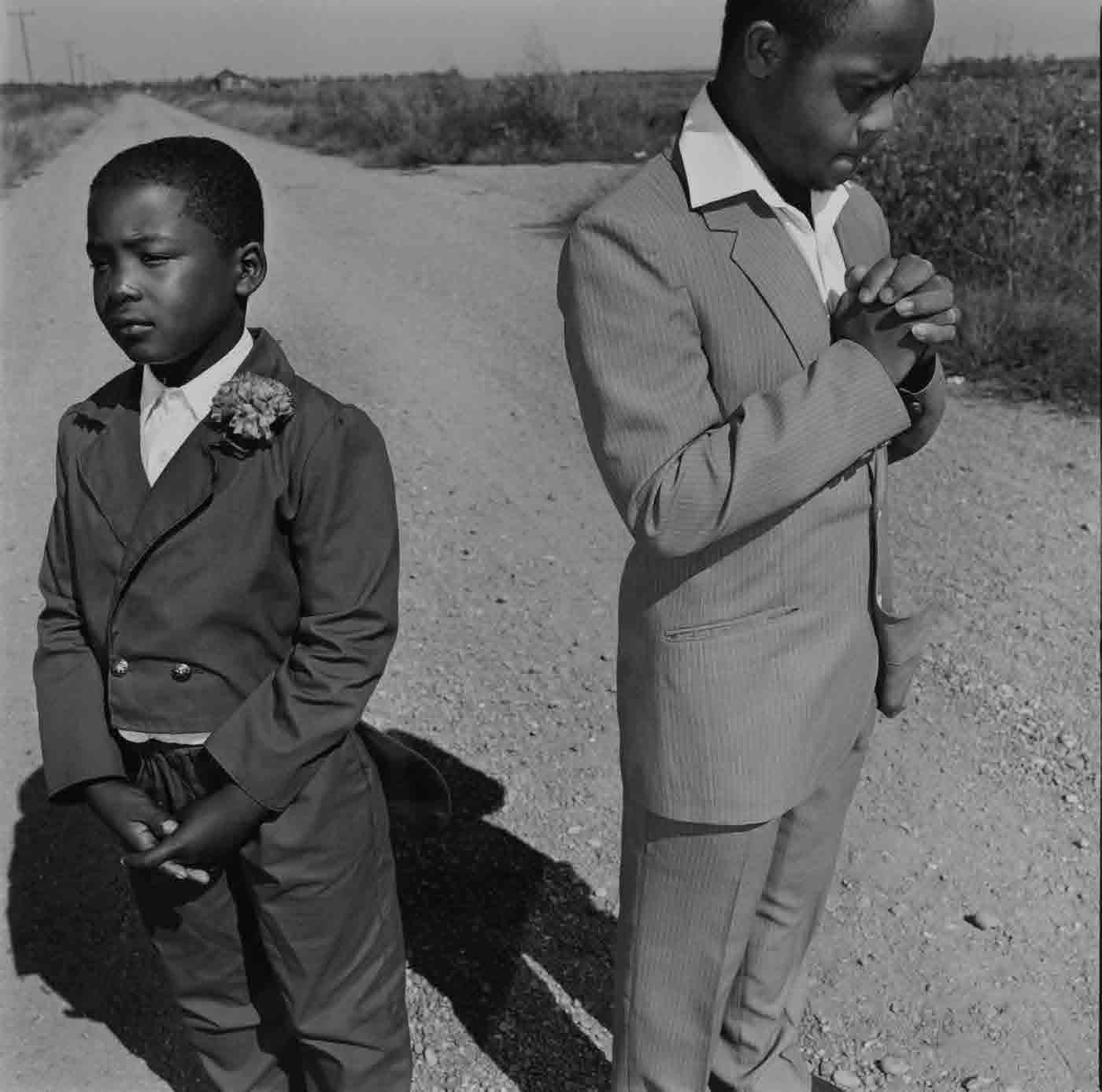
Gelatin silver print
10.25 x 10.25 in.
Hofstra University Museum of Art, gift of Susan and Steven Ball HU93.17.3
Track 5
Gordon Parks (American, 1912-2006)
Eye Music I, 1979

Dye transfer print
28 x 40.5 in.
Hofstra University Museum of Art, gift of Carole and Alex Rosenberg HU88.88
40 41
Track 6
Gordon Parks (American, 1912-2006)
Leopard, 1961
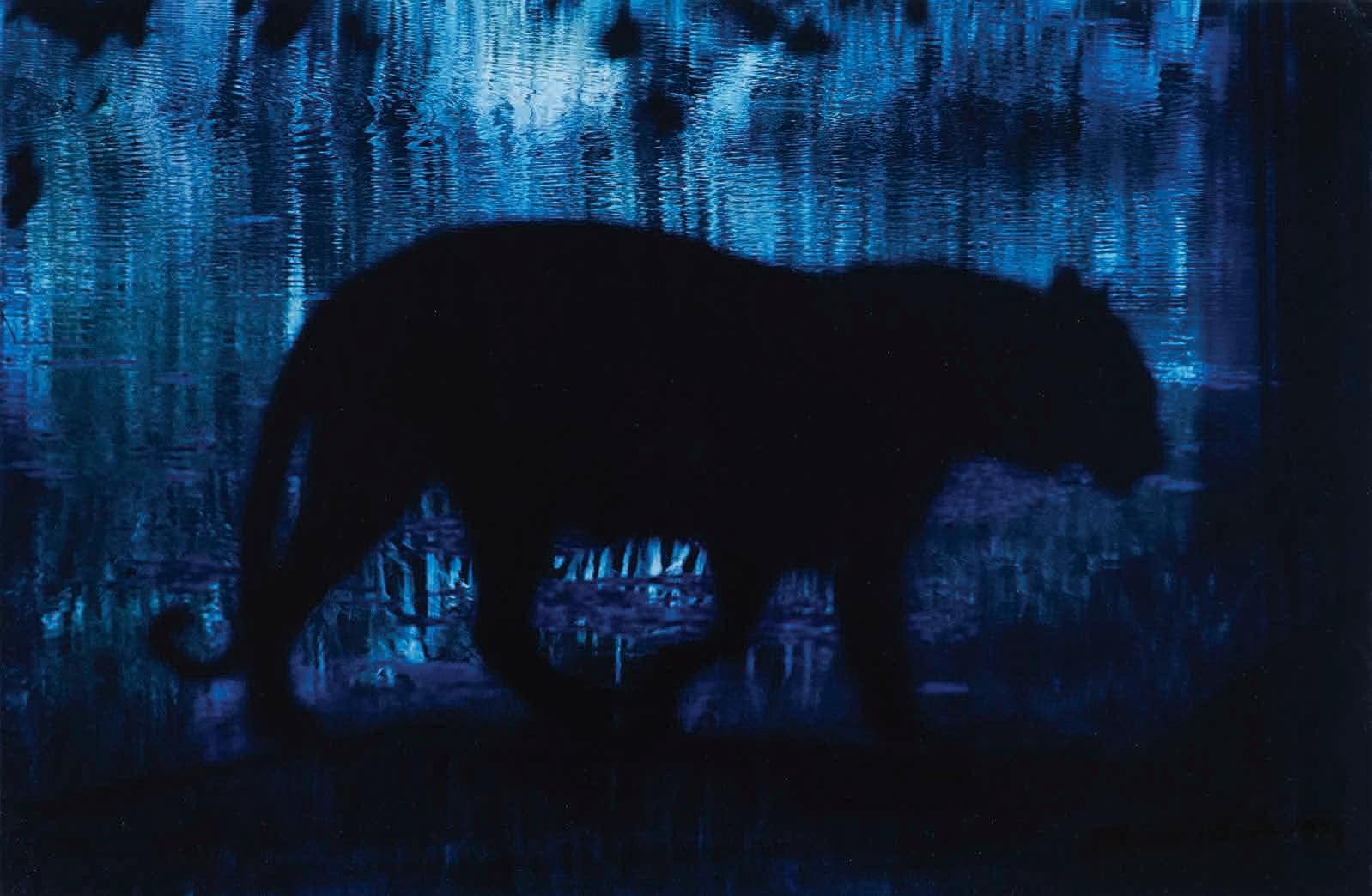
Dye transfer print
13 x 19.5 in Hofstra University Museum of Art, gift of Carole and Alex Rosenberg HU91.92
42 43
New Perspectives: The Museum of Art at 60 Exhibition Checklist
Berenice Abbott (American, 1898-1991)
Falling Balls of Unequal Mass, 1958, from the portfolio Retrospective, 1982 Gelatin silver print
23 x 9 in.
Hofstra University Museum of Art
Gift of Lazarus Weiner, HU83.28
African, Benin, Edo peoples
Standing Figure, 20th century Bronze with patina
15.75 x 5 x 5 in.
Hofstra University Museum of Art
Gift of Mr. and Mrs. Joseph Baird
HU66.3
African, Cameroon, Dowayo peoples
Namji Fertility Doll, early 20th century
Wood with patina, beads, leather, and metal
11.5 x 4.25 x 2 in.
Hofstra University Museum of Art
Gift of Dr. and Mrs. Pascal James Imperato, HU2021.5
African, Côte d’Ivoire, Dan peoples Female Face Mask (Deangle or Tankagle), 19th-mid 20th century Wood with pigment and patina
9.5 x 6 x 4 in.
Hofstra University Museum of Art
Gift of Josephine and Sol Levitts
HU85.58
African, Côte d’Ivoire, Dan peoples
Mask with Full Coiffure and Brass Bells, late 19th-early 20th centur y
Wood with cloth, raffia, reeds, brass, iron, and patina
26.5 x 12.5 x 13 in.
Hofstra University Museum of Art
Gift of Dr. and Mrs. Pascal James and Eleanor Imperato
HU2016.1
African, Mali, Dogon peoples Granary Door, early-mid 20th century
Wood
12 x 8.625 x 2.375 in.
Hofstra University Museum of Art
Gift of Roda Graham
HU2005.3.30
African, Mali, Dogon peoples Monkey Mask, early-mid 20th century
Wood with pigment and patina
11.5 x 5.75 x 4.5 in.
Hofstra University Museum of Art
Gift of Roda Graham
HU2005.3.16
African, Mali, Dogon peoples Monkey Mask, early-mid 20th century
Wood, pigment, patina
13 x 6 x 4.625 in.
Hofstra University Museum of Art
Gift of Roda Graham
HU2005.3.42
African, Mali, Dogon peoples
Necklace, early-mid 20th century
Iron, stone
15 x 3.5 x 1.5 in.
Hofstra University Museum of Art
Gift of Roda Graham
HU2005.3.2
African, Mali, Dogon peoples
Standing Male Figure, early-mid 20th century Wood, metal, iron, pigment, patina
37 x 11 x 15.75 in.
Hofstra University Museum of Art
Gift of Roda Graham
HU2005.3.25
Benny Andrews (American, 1930-2006) Chasty, 1961
Mixed media, oil and collage on canvas
18.25 x 24 in.
Hofstra University Museum of Art
Gift of Dr. and Mrs. Joseph Tucker
HU85.2
Tom Baril (American, born 1952)
Taughannock Falls #2, 2001, from the portfolio Tom Baril/Selected Images, 2004
Gelatin silver print
19.75 x 15.25 in.
Hofstra University Museum of Art
Gift of Susan and Steven Ball
HU2005.10.8
Marilyn Bridges (American, born 1948)
Crater, Andagua, Peru, 1989 Gelatin silver print
11 x 14 in.
Hofstra University Museum of Art
Gift of Peter and Susan Chatzky
HU2016.63
Marilyn Bridges
(American, born 1948)
Kazhitna Glacier, Denali, Alaska 1990, from the portfolio
Heightened Perspectives, 1990
Gelatin silver print
14.75 x 18.75 in.
Hofstra University Museum of Art
Gift of Susan and Steven Ball
HU95.14.9
Lucien Clergue
(French, born 1934)
Sicilian Botanic Garden I, from the portfolio New Dimensions: Lucien Clergue, 1988
Cibachrome color photographic print
10 x 32 in.
Hofstra University Museum of Art
Gift of Susan and Steven Ball
HU90.15.3
Conrad Felixmüller (German, 1897-1977)
The Happy Marriage/The Married Couple in Winter (Gluchkliche Ehe Iv/Ehepaar Im Winter), 1919
Oil on canvas
26 x 22.25 in.
Hofstra University Museum of Art
Gift of
Mr. and Mrs. Alexander Rittmaster
HU78.28
George Gach (American, born Hungary, 1909-1996) Maternity, 1963 Wood
51.875 x 25.25 x 9 in.
Hofstra University Museum of Art
Gift of Dr. and Mrs. Daniel Mason
HU86.80
Sally Gall
(American, born 1955)
Atchafalya, from the portfolio
Selected Landscapes, 1986
Gelatin silver print
15 x 15.125 in.
Hofstra University Museum of Art
Gift of Susan and Steven Ball
HU99.14.5
Sally Gall
(American, born 1955)
Tanah Lot, from the portfolio
Selected Landscapes, 1992
Gelatin silver print
15 x 15.125 in.
Hofstra University Museum of Art
Gift of Susan and Steven Ball
HU99.14.8
Anne Healy (American, born 1939)
Celtic Cloister, 1980
Photograph and collage
23.312 x 16.938 in.
Hofstra University Museum of Art
Gift of the artist
HU80.114
Katsushika Hokusai (Japanese, 1760-1849)
Mishima Pass in Kai Province (Koshu mishima-goe), from the series Thirty-Six Views of Mt. Fuji, 1830-1831
Color woodblock print, ink and color on paper
10 x 14.875 in.
Hofstra University Museum of Art
Gift of Helen Goldberg HU2003.8.3
Victoria Hutson Huntley (American, 1900-1971)
To New York
(Approaching New York), 1933
Lithograph
7.875 x 12.375 in.
Hofstra University Museum of Art
Gift of Daniel Mason HU77.98
J. Seward Johnson Jr. (American, 1930-2020)
Creating, 1982
Bronze
36 x 41 x 43.5 in.
Hofstra University Museum of Art
Hofstra University Purchase
HU85.68
Ellsworth Kelly (American, 1923-2015) Red Blue, from the portfolio X + X (Ten Works by Ten Painters), 1964 Screenprint on Mohawk Superfine cover paper 21.75 x 17.75 in.
Hofstra University Museum of Art Gift of Dr. Milton Gardner HU84.42
Dong Kingman (American, 1911-2000) Harlem Girl, undated Oil and collage on Masonite 31.25 x 24 in.
Hofstra University Museum of Art
Gift of Dr. Alfred Brotman HU74.09
Jirí Kolár (Czech, 1914-2002) Butterflies, 1968 Collage and pencil on paper 11.75 x 8.125 in.
Hofstra University Museum of Art Gift of anonymous donor HU91.11
George Koras (American, 1925-2015) Bull, 1961 Bronze 13 x 17 x 4 in.
Hofstra University Museum of Art Gift of Josephine and Sol Levitt HU84.49
Lee Krasner (American, 1908-1984) Free Space (Yellow), 1975 Screenprint and collage on Arches paper, deluxe edition 19.5 x 26 in.
Hofstra University Museum of Art
Gift of Carole and Alex Rosenberg HU88.13
44 45
Louis Lozowick
(American, born Ukraine, 1892-1973)
Into the Canyon, 1932
Lithograph
15.5 x 7.25 in.
Hofstra University Museum of Art
Gift of Daniel Mason
HU77.113
Louis Lozowick
(American, born Ukraine, 1892-1973)
Open Mine (Crushed Rock), 1937
Lithograph
14.375 x 10.125 in.
Hofstra University Museum of Art
Gift of Daniel Mason
HU77.107
Danny Lyon
(American, born 1942)
Cal, Springfield, Illinois, 1965
Gelatin silver print
13.25 x 9 in.
Hofstra University Museum of Art
Gift of George Stephanopoulos
HU2009.7.19
Mary Ellen Mark
(American, 1940-2015)
Brothers Going to Church, Tunica, Mississippi, from the portfolio
In America, 1990
Gelatin silver print
10.25 x 10.25 in.
Hofstra University Museum of Art
Gift of Susan and Steven Ball
HU93.17.3
Anton Mauve (Dutch, 1838-1888)
Untitled, undated
Ceramic
16 x 24 in.
Hofstra University Museum of Art
Gift of Mr. and Mrs. Howard Weingrow
HU80.107
Melanesia, Kiriwina Islands, Papua New Guinea, Massim peoples
War Club, early-mid 20th century
Wood with pigment
34.25 x 5.25 x 0.75 in.
Hofstra University Museum of Art
Gift of Cedric H. Marks
HU73.92
Joan Mitchell (American, 1925-1992)
Metro, c. 1965
Oil on canvas
20 x 17 in.
Hofstra University Museum of Art
Gift of Dr. and Mrs. Milton Gardner
HU80.15
Albert N’Kusu (Congolese, born 1914)
Tam-Tam Drummer, 1962
Oil on canvas board
32 x 24 in.
Hofstra University Museum of Art
Gift of Olga Brom Spencer
HU2001.13.1
Max Papart (French, 1911-1994)
Untitled, 1975
Etching and collage
6.5 x 7 in.
Hofstra University Museum of Art
Gift of Carole and Alex Rosenberg
HU86.198
Gordon Parks (American, 1912-2006)
Eye Music I, 1979
Dye transfer print
28 x 40.5 in.
Hofstra University Museum of Art
Gift of Carole and Alex Rosenberg
HU88.88
Gordon Parks (American, 1912-2006)
Labyrinth, 1981
Dye transfer print
20 x 29.5 in.
Hofstra University Museum of Art
Gift of Carole and Alex Rosenberg
HU88.84
Gordon Parks (American, 1912-2006)
Leopard, 1961
Dye transfer print
13 x 19.5 in
Hofstra University Museum of Art
Gift of Carole and Alex Rosenberg
HU91.92
Gordon Parks (American, 1912-2006)
Rose (White), 1981
Dye transfer print
20 x 29 in.
Hofstra University Museum of Art
Gift of Carole and Alex Rosenberg
HU88.87
Gordon Parks (American, 1912-2006)
Vide Noir, 1981
Dye transfer print
29.5 x 19.75 in.
Hofstra University Museum of Art
Gift of Carole and Alex Rosenberg
HU88.154
Jane Peterson (American, 1876-1965)
The Lagoon, Venice, 1920
Oil on canvas
32 x 32 in.
Hofstra University Museum of Art
Gift of Martin Horwitz
HU72.1
Howardena Pindell (American, born 1943)
Untitled #9B (Genesis II), 2007
Watercolor, acrylic, thread, ink, oil
stick, color pencil, and museum board
13 x 10.75 x 3 in.
Hofstra University Museum of Art
Gift of the artist
HU2012.51
Robert Rauschenberg (American, 1925-2008)
Stunt Man #1, 1962
Lithograph
17 x 13 in.
Hofstra University Museum of Art
Gift of Dr. Milton M. Gardner
HU70.101
Barbara Roux (American, born 1945)
Storm Approaching From the Sound, 2010
Digital print
12 x 18 in.
Hofstra University Museum of Art
Gift of the artist
HU2012.3
Louis Schanker (American, 1903-1981)
Polo, 1940 Woodcut
8.875 x 7.25 in.
Hofstra University Museum of Art
Gift of Lou Siegel
HU97.10
Ben Shahn
(American, born Lithuania, 1898-1969)
Scientist, 1957
Screenprint with hand-coloring
12 x 10 in.
Hofstra University Museum of Art
Gift of Ralph Barrocas
HU2009.2.3
Burton Silverman (American, born 1928)
The New Woman, 1960
Charcoal on paper
10.5 x 7 in.
Hofstra University Museum of Art
Gift of Harvey Dinnerstein
HU70.67
Jerry Uelsmann (American, 1934-2022)
Home is a Memory, 1963
Gelatin silver print
12.75 x 9.75 in.
Hofstra University Museum of Art
Gift of the Long Beach
Friends of Hofstra
HU72.68
Brett Weston (American, 1911-1993)
Driftwood, 1958
Gelatin silver print
7.75 x 9.6875 in.
Hofstra University Museum of Art
Gift of the Christian Keesee Collection
HU2021.9
Brett Weston (American, 1911-1993)
Lava and Plant, Hawaii, 1980
Gelatin silver print
13.5625 x 10.5625 in.
Hofstra University Museum of Art
Gift of the Christian Keesee Collection
HU2021.28
Brett Weston (American, 1911-1993)
Mud Cracks, 1977
Gelatin silver print
10.5625 x 13.6875 in.
Hofstra University Museum of Art
Gift of the Christian Keesee Collection
HU2021.24
Brett Weston (American, 1911-1993)
Wood, 1975
Gelatin silver print
10.6875 x 13.625 in.
Hofstra University Museum of Art
Gift of the Christian Keesee Collection
HU2021.30
46 47
HOFSTRA UNIVERSITY
SUSAN POSER President
CHARLES G. RIORDAN
Provost and Senior Vice President for Academic Affairs
COMILA SHAHANI-DENNING
Senior Vice Provost for Academic Affairs
HOFSTRA UNIVERSITY MUSEUM OF ART
KAREN T. ALBERT Director
TAMARA ALFANO Museum Educator
KRISTEN DORATA
Collection Manager
JACKIE GEIS
Senior Assistant to Director
ALEXANDRA GIORDANO
Assistant Director of Exhibition and Collection
STEPHANIE MCGEE
Museum Educator
EILEEN MCKENNA Museum Educator
SARA SCHAEFER Museum Educator
AMY G. SOLOMON Director of Education
GRADUATE ASSISTANTSHIP
Mary Conroy
UNDERGRADUATE ASSISTANTS
Makayla Egolf, Syd Hartstein, Angelina Olivo, Bella Palaia, Josie Racette, Aurisha Rahman, Paxton Splittorff, Caitlin Treacy
48 49












 Hofstra University Museum of Art, gift of the artist HU2012.3
Hofstra University Museum of Art, gift of the artist HU2012.3


 Lyon (American, born 1942)
Hofstra University Museum of Art, gift of George Stephanopoulos HU2009.7.19
Robert Rauschenberg (American, 1925-2008)
Lyon (American, born 1942)
Hofstra University Museum of Art, gift of George Stephanopoulos HU2009.7.19
Robert Rauschenberg (American, 1925-2008)








 Hofstra University Museum of Art, gift of Martin Horwitz HU72.1
Hofstra University Museum of Art, gift of Martin Horwitz HU72.1









